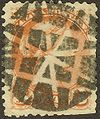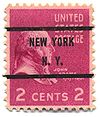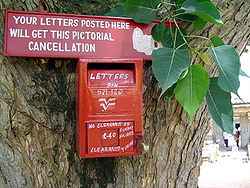
Cancellation
Encyclopedia

Postal marking
A postal marking is any kind of annotation applied to a letter by a postal service. The most common types are postmarks and cancellations; almost every letter will have those. Less common types include forwarding addresses, routing annotations, warnings, postage due notices and explanations, such...
applied on a postage stamp
Postage stamp
A postage stamp is a small piece of paper that is purchased and displayed on an item of mail as evidence of payment of postage. Typically, stamps are made from special paper, with a national designation and denomination on the face, and a gum adhesive on the reverse side...
or postal stationery
Postal stationery
A piece of postal stationery is a stationery item, such as a stamped envelope, letter sheet, postal card, lettercard, aerogram or wrapper, with an imprinted stamp or inscription indicating that a specific rate of postage or related service has been prepaid...
to deface the stamp and prevent its re-use. Cancellations come in a huge variety of designs, shapes, sizes and colors. Modern United States cancellations commonly include the date and post office location where the stamps were mailed, in addition to lines or bars designed to cover the stamp itself. The term "postal marking" sometimes is used to refer specifically to the part that contains the date and posting location, although the term often is used interchangeably with "cancellation." The portion of a cancellation that is designed to deface the stamp and does not contain writing is also called the "obliteration" or killer
Killer (philately)
In philately a killer is a particularly heavy type of handstamp consisting of heavy bars, cork impressions or other crude devices used to cancel postage stamps...
. Some stamps are issued pre-cancelled with a printed or stamped cancellation and do not need to have a cancellation added. Cancellations can affect the value of stamps to collectors, positively or negatively. The cancellations of some countries have been extensively studied by philatelists and many stamp collectors and postal history collectors collect cancellations in addition to the stamps themselves.
History
The first adhesive postage stampPostage stamp
A postage stamp is a small piece of paper that is purchased and displayed on an item of mail as evidence of payment of postage. Typically, stamps are made from special paper, with a national designation and denomination on the face, and a gum adhesive on the reverse side...
was the Penny Black
Penny Black
The Penny Black was the world's first adhesive postage stamp used in a public postal system. It was issued in Britain on 1 May 1840, for official use from 6 May of that year....
, issued in 1840 by Great Britain
Postage stamps and postal history of Great Britain
Postage stamps and postal history of Great Britain surveys postal history from the United Kingdom and the postage stamps issued by that country and its various historical territories until the present day....
. The postal authorities recognized there must be a method for preventing reuse of the stamps and simultaneously issued hand stamps for use to apply cancellations to the stamps on the envelopes as they passed through the postal system. The cancels were handmade and depicted a Maltese cross
Maltese cross
The Maltese cross, also known as the Amalfi cross, is identified as the symbol of an order of Christian warriors known as the Knights Hospitaller or Knights of Malta and through them came to be identified with the Mediterranean island of Malta and is one of the National symbols of Malta...
design. Initially, the ink used was red, which was difficult to see against the black stamps, and the ink color was subsequently changed to black.
Britain soon abandoned the Maltese crosses and in 1844 began to employ cancellations displaying numbers which referred to the location of mailing. A similar scheme was used for British stamps used abroad in its colonies and foreign postal services, with locations being assigned a specific letter followed by a number, such as A01 used in Kingston, Jamaica, or D22 for Venezuela.

Marker pen
thumb|MarkerA marker pen, marking pen, felt-tip pen, flow or marker, is a pen which has its own ink-source, and usually a tip made of a porous, pressed fibres; such as felt or nylon.-Permanent marker:...
.

United States
The United States of America is a federal constitutional republic comprising fifty states and a federal district...
a number of patent
Patent
A patent is a form of intellectual property. It consists of a set of exclusive rights granted by a sovereign state to an inventor or their assignee for a limited period of time in exchange for the public disclosure of an invention....
s were issued for cancelling devices or machines that increased (or were purported to increase) the difficulty of washing off and reusing postage stamps. These methods generally involved the scraping or cutting-away of part of the stamp, or perhaps punching a hole through its middle. (These forms of cancellation must be distinguished from perfins, a series of small holes punched in stamps, typically by private companies as an anti-theft device.)
High speed cancellation machines were first used in Boston between 1880-1890 and subsequently throughout the country.
Today, cancellations may either be applied by hand or machine. Hand cancellation is often used when sending unusually shaped mail or formal mail (e.g., wedding invitations) to avoid damage caused by machine cancellation.
Postal meter stamps and similar modern printed to order stamps are not ordinarily cancelled by postal authorities because such stamps bear the date produced and can not readily be re-used.
Types of cancellations
- Bullseye cancellationSocked on the noseSocked on the nose , also called Bullseye cancel, in philately, refers to a cancellation of a postage stamp in which the postmark, typically a circle with the date and town name where mailed, has been applied centered on the stamp...
also called "Socked on the nose" or SOTN, is a stamp collector's term for a cancellation, typically of circular design, centered on the postage stamp. Such cancellations are popular with some stamp collectors because of their neatness and the fact that the time, date, and location where the stamp was used may be readily seen. The prevalence of bulls-eye cancellations varies considerably by country and time period.
- Cancelled-to-orderCancelled-to-orderA cancelled to order postage stamp is a stamp the issuing postal service has cancelled , but has not traveled through the post, but instead get handed back to a stamp collector or dealer. They can come from withdrawn stocks of stamps cancelled in sheets and sold as remainders or from new sheets...
. Cancelled-to-order stamps, also known as CTOs, are stamps that have been cancelled by a postal authority, but were never used to transmit mail. CTOs are created by postal authorities to sell the stamps cheaply to stamp collectors. Many Eastern European countries and others sold great numbers of CTOs to collectors in the 1950s - 1990s strictly for revenue. CTOs often may be identified as the stamps still retain their original gum. Some authorities use the same canceller for all CTOs, and apply it very neatly in the corner of four stamps at one time. In some instances, the "cancellations" are actually printed as part of the stamp itself.
- Deferential cancellation is a cancellation designed so as not to deface the image of the ruler or regent on the stamp. See example above.

- A duplex cancelDuplex cancelA duplex cancel was a hand stamp used to cancel postage stamps and imprint a dated postmark applied simultaneously with the one device. The device had a steel die, generally circular, which printed the location of the cancel, together with the time and date of cancel...
includes a postmark as well as the cancellation.
- Fancy cancels. In the second half of the 19th century, many postmasters in the United States and Canada cut their own cancelers from corkCork (material)Cork is an impermeable, buoyant material, a prime-subset of bark tissue that is harvested for commercial use primarily from Quercus suber , which is endemic to southwest Europe and northwest Africa...
or wood in a great variety of designs such as stars, circles, flags, chickens, etc. These are known as fancy cancels and have been heavily studied by philatelists and collectors. One of the most famous is the "kicking mule" used in the 1880s.
- First day of issueFirst day of issueA First Day of Issue Cover or First Day Cover is a postage stamp on a cover, postal card or stamped envelope franked on the first day the issue is authorized for use within the country or territory of the stamp-issuing authority. Sometimes the issue is made from a temporary or permanent foreign or...
are special cancellations with the date the stamp was first issued for sale and the words "first day of issue."
- Flag cancellations are a type of machine cancellation incorporating a design of the United States flag with the stripes serving as the "killer". The first machine flag cancel (preceded by fancy cancels of flags) was used in Boston in November-December 1894.
- Handstamped cancellations are cancellations added by means of a hand stamping device.
- Highway post office cancels refers to cancels added in transit by portable mail-handling equipment for sorting mail in trucks.
- Machine cancellationsMachine postmarkA machine postmark or machine cancellation is a postmark or cancellation on mail that is applied by a mechanical device rather than with the use of a handstamp. Nearly all machine-cancellation devices apply both postmark and cancellation simultaneously...
are automatically added by machines that rapidly process large numbers of envelopes. A 1903 silent film of an operating cancelling machine may be seen here.
- Mute cancel refers to a cancellation that includes no writing and thus "does not speak."
- Numeral cancels are cancels whereby number were used to identify specific post offices. For the United Kingdom of Great Britain and IrelandUnited Kingdom of Great Britain and IrelandThe United Kingdom of Great Britain and Ireland was the formal name of the United Kingdom during the period when what is now the Republic of Ireland formed a part of it....
, which started using numerals in 1844, the shape of bars indicate the actual country of use. Numerals were also used in combination with a datestamp in duplex cancellations.
- Pen cancelPen cancelthumb|A pen cancel on a Russian [[postage stamp]].In philately, a pen cancel is a cancellation of a postage or revenue stamp by the use of a pen, marker or crayon.- Usage :...
s refer to the use of a writing penPenA pen is a device used to apply ink to a surface, usually paper, for writing or drawing. Historically, reed pens, quill pens, and dip pens were used, with a nib of some sort to be dipped in the ink. Ruling pens allow precise adjustment of line width, and still find a few specialized uses, but...
to deface the stamp, and were more common in the 19th and early 20th centuries.
- Pictorial cancellations include images associated with the commemoration of some event or anniversary. Some people attempt to use stamps relating to the theme of a pictorial cancellation on the envelope. See further below.

- PrecancelPrecancelA precanceled stamp, or precancel for short, is a postage stamp that has been cancelled before being affixed to mail. Precancels are typically used by mass mailers, who can save a postal system time and effort by prearranging to use the precancels, and delivering the stamped mail ready for sorting...
s are stamps that have been issued with printed cancellations on them, typically to mass mailers. Precancels cannot normally be used by the general public.
- Railway post office (R.P.O.) cancelsRailway post officeIn the United States a railway post office, commonly abbreviated as RPO, was a railroad car that was normally operated in passenger service as a means to sort mail en route, in order to speed delivery. The RPO was staffed by highly trained Railway Mail Service postal clerks, and was off-limits to...
refer to cancellations applied on mail sorted on trains. The first United States cancellation with the word "railroad" dates from 1838. The last Railway Post Office (R.P.O.) operated by the United States closed in 1977.
- Ship cancelsMail steamerMail steamers were steamships which carried the mail across waterways, such as across an ocean or between islands, primarily during the 19th Century and early 20th Century, when the cost of sending a letter was declining to the point an ordinary person could afford the cost of sending a letter...
were added to stamps that were mailed on or carried on a ship, commonly a steamer ship in the late 19th-early 20th centuries. In French, the cancellation reads "Paquebot".
- Slogan cancellations contain a slogan, perhaps commemorative or advertising, in the killer box. See further below.
Pictorial and special cancellations

United States Postal Service
The United States Postal Service is an independent agency of the United States government responsible for providing postal service in the United States...
distinguishes between special cancellations which have a caption publicizing an event, and pictorial cancellations, which contain an image of some sort. Special cancellations are essentially a type of slogan cancellations.

Post office
A post office is a facility forming part of a postal system for the posting, receipt, sorting, handling, transmission or delivery of mail.Post offices offer mail-related services such as post office boxes, postage and packaging supplies...
s existing only for a limited time, usually one day, at special events, although there are frequently other pictorial cancellations that are not officially described as such — they are among what are called special cancellations and are special die-hubs added to machine cancels, which usually contain merely a slogan but sometimes contain a picture.
There are a very few exceptions in which a particular post office uses a pictorial cancellation on all its mail.

Canada Post
Canada Post
Canada Post Corporation, known more simply as Canada Post , is the Canadian crown corporation which functions as the country's primary postal operator...
uses automated cancellations with computer-printed messaging. In this way, the corporation can automatically print promotional messages on each envelope while simultaneously cancelling the piece of mail. Messages change throughout the year, and include seasonal messages ("Merry Christmas / Joyeux Noel") and promotional messages (such as Canada Post's web address).
Other post offices such as the Isle of Man Philatelic Bureau
Isle of Man Post
The Isle of Man Post Office , which formerly used the trading name Isle of Man Post, operates postal collection, ancillary mail services, philatelic goods and delivery services and post office counter services on the Isle of Man.-History:...
also create special pictorial cancellations as they did in 1985 to mark the anniversary of the aircraft Douglas DC-3. A special handstamp was created depicting a Dakota flying "free" and not "boxed in".
Collectors
Generalist stamp collectors usually prefer lightly cancelled stamps which have the postmark on a corner or small portion of the stamp without obscuring the stamp itself, which ordinarily are more valuable than heavily-cancelled stamps. In order to get the postal clerk to cancel the stamps lightly, collectors may rubber-stamp or write "philatelic mail" on the envelope.Cancellations may significantly affect the value of the stamps. Many stamps are rarer, and consequently much more expensive, in unused condition, such as the Penny Black, which in 1999, catalogued for $1,900 mint and $110 used. The reverse is true for some stamps, such as the hyperinflation stamps of Germany
Postage stamps and postal history of Germany
This is a survey of the postage stamps and postal history of Germany and philatelically related areas. The main modern providers of service were the Reichspost , the Deutsche Post under Allied control , the Deutsche Post of the GDR , the Deutsche Bundespost , along with the Deutsche Bundespost...
, which may be worth many times more if genuinely postally used. Where stamps are much more valuable in used condition than unused, it may be advisable to have such stamps expertised
Expertization
Expertization is the process of authentication of an object, usually of a sort that is collected, by an individual expert or a committee of experts.The expert committee will examine the collectible and issue a certificate typically including:...
to confirm that the cancellation is genuine and contemporary.
Some stamp collectors are interested in the cancellations themselves, on or off cover, of a particular country or issue, or collect a specific type of cancellation, such as fancy cancels. There have been many published studies of the cancellations of many countries, some of which are listed below. Collectors who are interested in the cancellations themselves prefer bold, readable cancellations. Cancellations also are an integral part of the collection of postal history
Postal history
Postal history is the study of postal systems and how they operate and, or, the study of postage stamps and covers and associated material illustrating historical episodes of postal systems...
.
Historically, collectors disliked pen cancels and removed many of them, making the stamp appear unused or to add a fake cancellation. Today, early United States pen cancelled stamps still are worth considerably less than examples with hand stamped cancels.
Collectors generally view modern cancelled-to-order stamps or CTOs as philatelic junk, and they rarely have any significant value. Stamp catalogs commonly state whether their values for used stamps are for CTOs or for postally used examples. For example, the Scott Catalog used value listings for the German Democratic Republic are for CTOs from 1950 through mid-1990, over 2700 stamps.
Forgeries
Forgers have not only manufactured stamps for the philatelic market, they have added forged cancellations to those stamps. This was especially common in the late 19th century and early 20th century, when huge numbers of inexpensive stamps were forged for the packet trade.Forged cancellations have also be applied to genuine stamps, in cases where the stamps are worth much more postally used. In addition, where rare cancellations are desired by collectors, those cancellations have also been forged.
Cancellations also may be used to prove that certain philatelic items are genuine. For example, forgers have fabricated many supposedly valuable postal covers by adding genuine stamps and forged postal markings to pre-stamp covers. A cover can be shown to be genuine if a genuine cancellation "ties" the stamp or stamps to the cover; that is, if a genuine cancellation runs continuously over the stamp and adjacent portion of the envelope, although one still may need to rule out the possibility that the cancellation was added later. Similarly, stamps that were cut in parts and used for a portion of the full value as splits can only be shown to have been so used if a genuine cancel ties the stamp to the cover or piece of cover.
Studies of cancellations
Great Britain & Ireland- R.C. Alcock & F.C. Holland, The Postmarks of Great Britain and Ireland, 1660-1940 (Alcock, Cheltenham 1940)(and supplements).
- George Brumell, British Post Office Numbers 1844-1906 (Alcock, Cheltenham 1971).
- Robert Danzig & David Goldsmith, The Cancellations of the 1841 Penny Red (Philatelic Imprint, London 1991).
- William Kane, Catalogue of the postal markings of Dublin, c. 1840-1922 (M.P.Giffney, Dublin 1981).
- John Parmenter, Michael Goodman, & John Saylor, Jr., Barred Numeral Cancellations, Vols. I-IV (1985-1988).
- H.C. Westley, The Postal Cancellations of London, 1840-1890 (H.F. Johnson 1950).
- J.T. Whitney, Collect British Postmarks: Handbook to British Postal Markings and Their Values (British Postmark Society).
United States
- James M Cole, Cancellations and Killers of the Banknote Era, 1870-1894 (U.S. Philatelic Classics Society Columbus, OH 1995).
- Kenneth L. Gilman, The New Herst-Sampson catalog : a Guide to 19th century United States Postmarks and Cancellations (D.G. Phillips Pub. Co. North Miami, FL 1989).
- R. F. Hanmer, A collector's guide to U.S. Machine Postmarks, 1871-1925: with examples of later types (D.G. Phillips Pub. Co. North Miami 3d rev. ed. 1989).
- Herman Herst, Jr., Fancy Cancellations on Nineteenth Century United States Postage Stamps (Shrub Oak, New York 3rd rev. ed. 1963).
- Foster W. Loso, Twentieth Century United States Fancy Cancellations (Somerset Press, c. 1952).
- Moe Luff, United States Postal Slogan Cancel Catalog (Spring Valley, N.Y. rev. ed 1968).
- Sol Salkind, U.S. Cancels 1890-1900, with Special Emphasis on the Fancy Cancels found on the 2¢ Red Definitive Stamps of this period (David G. Phillips Co. c. 1985).
- Hubert C. Skinner & Amos Eno, United States Cancellations, 1845-1869:Unusual and Representative Markings (American Philatelic Society, State College, PA 1980).
- Scott R. Trepel, U.S. postmarks and cancellations (Philatelic Foundation, New York 1992).
- William R. Weiss, Jr. & Foster W. Loso, The Complete Pricing Guide of United States 20th Century Fancy Cancellations (W.R. Weiss, Jr. 1987).
- Michel Zareski & Herman Herst, Fancy Cancellations on 19th Century United States Postage Stamps (Shrub Oak, NY. 3d rev. ed. 1962).
Canada
- K. M. Day, Canadian Fancy Cancellations of the Nineteenth Century (British North America Philatelic Society, Toronto 1963).
- D.M. Lacelle, Fancy cancels on Canadian stamps 1855 to 1950 (British North America Philatelic Society Ltd., Ottawa 2007).
- Lewis M. Ludlow, Catalogue of Canadian railway cancellations and related transportation postmarks (L.M. Ludlow, Tokyo 1982).
- G.Douglas Murray, 2000 postmarks of Prince Edward Island, 1814 to 1995 (Retrospect Pub., Charlottetown, PEI 1996).
France
- Jean Pothion, France Obliterations 1849-1876 (La Poste aux Letters, Paris 1975).
Elsewhere
- Archibald George Mount Batten, The Postmarks of the Orange Free State and the Orange River Colony, 1868-1910 (1972).
- H.M. Campbell, Queensland cancellations and other postal markings 1860-1913 (Royal Philatelic Society of Victoria, Melbourne 1977).
- John H. Coles & Howard E. Walker, Postal Cancellations of the Ottoman Empire (Christie’s-Robson Lowe, London [1984]-1995).
- R.J.G. Collins, The Cancellations of New Zealand: with notes on the early philatelic history (Kiwi Publishers Christchurch, N.Z. 1926 (1995)).
- H.C. Dann, The cancellations of the Rhodesias and Nyasaland (Robson Lowe Ltd., London 1950).
- Roger Hosking, Paquebot Cancellations of the World (Oxted 1977).
- Tom Lee & John Watts, New Zealand pictorial and special event date stamps, 1882-2002(North Shore Philatelic Society, Auckland 2002).
- D.R. Martin, Numbers in Early Indian Cancellations, 1855-1884 (Robson Lowe, London 1970).
- J.R.W. Purves, Victoria: the "Barred Numeral" Cancellations, 1856-1912, and the post offices which used them (Royal Philatelic Society of Victoria, Melbourne 1963).
- Joseph Schatzkes (rev. Karl H. Shimmer), The Cancellations of Mexico, 1856-1874 (W.E. Shelton n.p.1983).
- Derek Willan (editor), Greek Rural Postmen and Their Cancellation Numbers (Hellenic Philatelic Society of Great Britain, 1994)
- Illustrated Ottoman Turkish Postmarks 1840-1929 ("Resımlı Osmanli - Tűrk Posta Damgalari") (10 vols in process).
Organizations
- The US Cancellations Club
- The International Machine Cancel Society
- U.S. Philatelic Classics Society
- The Precancel Stamp Society
- British Postmark Society
- Post Mark Collectors Club
- Bullseye Cancel Collectors' Club

